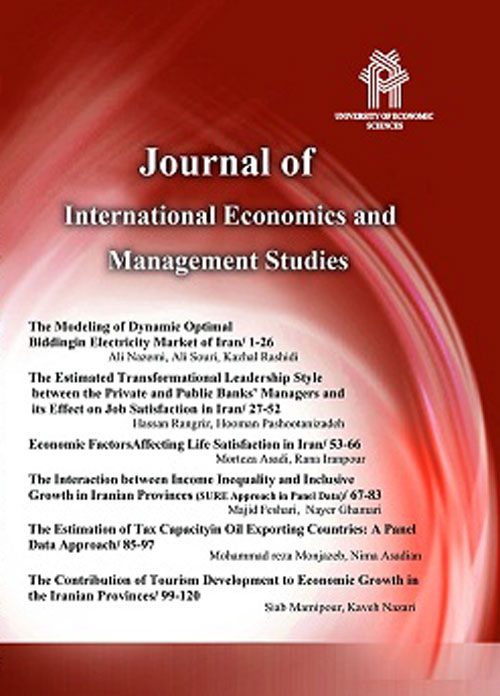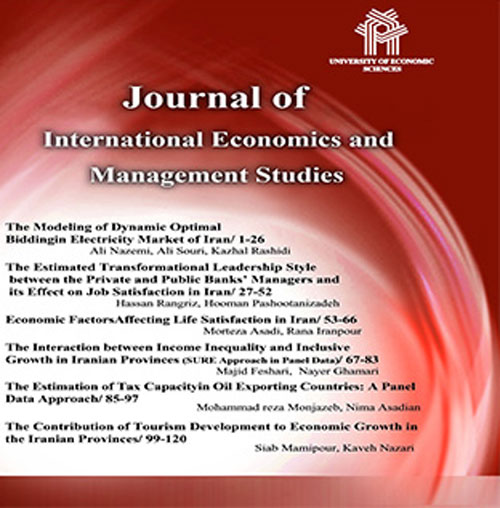فهرست مطالب

International Journal of Economics and Management Studies
Volume:1 Issue: 2, 2016
- تاریخ انتشار: 1395/02/28
- تعداد عناوین: 6
-
Pages 1-19Energy intensity is a measure of the energy efficiency of a nations economy. Many factors influence a countrys energy intensity. In this paper, however, we note the effective factors of energy intensity and decompose it by applying Logistic Smooth Transition Regression (LSTR) in Iran during the period 1980- 2013. The main factors are the ratio of the added value of services to GDP (explaining both linear and nonlinear part of the energy intensity), the percentage of internet users, income per capita and Human Development Index (explaining nonlinear part of the energy intensity). The results indicated that the lifestyle and structural changes had a significant and considerable effect on decreasing energy intensity and that the ratio of services value-added to GDP as a transition variable caused an asymmetric behavior of energy intensity affected from explanatory variables. The most effective factor on energy intensity was Human Development Index.Keywords: Energy Intensity, Energy Efficiency, LSTR Model, Iran
-
Pages 21-48Tax is one of the main sources of financing government budget. Therefore, having a clear picture about the attainable amount of taxes are not only necessary for optimal allocation of scarce resources for tax collection, but also helps the government to develop precise tax collection programs .In this article, the structural features of the tax revenues series have first been examined in relation to linearity, chaotic nonlinearity and stochasticity, using Lyapunov Exponent. These series are: total taxes, direct taxes, indirect taxes, corporate taxes, income taxes, salary taxes, real estates taxes, business taxes, wealth taxes, inheritance taxes and goods & services taxes. The results indicated the existence of a chaos in the series of different tax resources with different weakness and severity. Therefore, based on the results it was found that we can do more accurate short-term predictions by applying nonlinear modeling. In the next step, using the data of the period 1963-2006,the tax revenues of different resources were forecasted for the period 2007-2009 by applying both parallel and proposed Multiple-input Multiple-output structures of the ANNs.Keywords: Tax, forecast, chaos, Lyapunov exponent, artificial neural networks, parallel models, multiple-input multiple-output model
-
Pages 49-69Growth quality index (QGI) is affected by two sets of structural and social composite indicators. Structural indicator contributes to achieve the main target of sound, sustainable, and competitive output growth. By the way, the sound output growth should enhance social public services and living standard. Although QGIs are computed based on different scenarios, the trend of the QGIs and coefficient of variation of the QGIs indicate the robustness of the results. The Correlation among QGI and social sub-components highlights a positive relationship between QGI and school enrollment, per capita income and public spending on education and health. The result of cointegration model indicates that higher government size and devaluation of local currency have evidently exacerbated QGI. Meanwhile, openness and inflation underscore the positive long-run impact over QGI. Furthermore, vector error correction equation outlines that about 84 percent of a short-term shock to the cointegrating vector will be absorbed in the first period. In this context, the impulse response of the QGI to the exchange rate and government size shocks are diminishingly and negatively permanent while the response of the QGI to the shocks of openness is significantly and positively permanent.Keywords: Quality of growth, Structural indicators, Social indicators
-
Pages 71-81The main objective of this study was to examine the relationship between Value at Risk (VaR) and expected returns from 2002 to 2013 in Tehrans Stock Exchange. In this study parametric value at risk, which considers the distribution of returns as normal and the historical value at risk as abnormal, was used to test the presence of the volatility anomaly in the companies listed in Tehrans Stock Exchange. Also, this study controlled the impact of the variables (Firm size, Book value to Market value) and the relationship between Value at Risk and expected return.
The results of the analysis of the panel data showed a significant positive relationship between the parametric VaR , historical VaR and expected returns during the period under review .The results showed that the control variables didnt have an effect on the relationship between Value at Risk and expected returns.Keywords: Value at Risk, Expected Return, Volatility Anomaly -
Pages 83-96Purpose - The aim of this paper is to describe the population ecology theory through fractal thinking, an emergent human operating system that is creative, adaptive, healthy, and evolutionary; furthermore, a parallel is drawn between the population ecology model and the fractal structure. Top-down hierarchies are typically characterized by command and control systems of the authority that creates harmful stress and internal competition for advancement within organizations as environment control survival of the organizations based on population ecology theory. To further diminish the tendency towards internal competition, forward-thinking organizations may adopt an in-out pattern instead of top-down. This article tries to imply such pattern.
Design/methodology/approach -The fractal concept is applied to the organizational population ecology. It can be used to describe the strategy of management within an organizational environment.
Findings - By applying the fractal thinking to an organizational population ecology theory, we try to evolve a never-ending and complex pattern that is self-similar across different scales in the scope of organizations and their environments. We consider repeating a simple process over and over in an ongoing feedback loop in organizations. The new perspective presented in our discussion lends itself to the description of the current pattern of organizational growth within the fractal strategy.
Practical implication - The organizational ecology theory through fractal management describes how fractal concepts impact success. A fractal approach allows managers to ascertain the effectiveness of their organizations in the ecosystem and accordingly, devise strategies to embrace changes and challenges of the global environment.
Originality/value - The conceptual framework of the population ecology via fractal structures offers promise for a more sophisticated and methodologically rigorous approach to future investigations by the re- searchers. The population ecology theory based on fractal structures is an extension of the literature.Keywords: Fractal concept, Population ecology theory, Top, down hierarchy, Evolutionary -
Pages 97-117The global economy faces crisis every so often. In recent years, the financial crisis has affected the global economy; all countries, directly or indirectly, are involved. The purpose of this research is to study the impact of the global economic crisis on the capital structure of listed companies in Tehran Stock Exchange. To test this effect, 87 companies listed in Tehran Stock Exchange during the period 2008- 2012 have been studied. In this study, earnings before interest and tax, depreciation expense, assets, research and development expenses, and global economic crisis are used as the independent variables. The book debt ratios and the market debt ratios are used as the dependent variables (the capital structure). The results suggest a significant relationship between the global economic crisis and the market debt ratios but not the book debt ratios.Keywords: Economic crisis, capital structure, market debt ratios, book debt ratios


